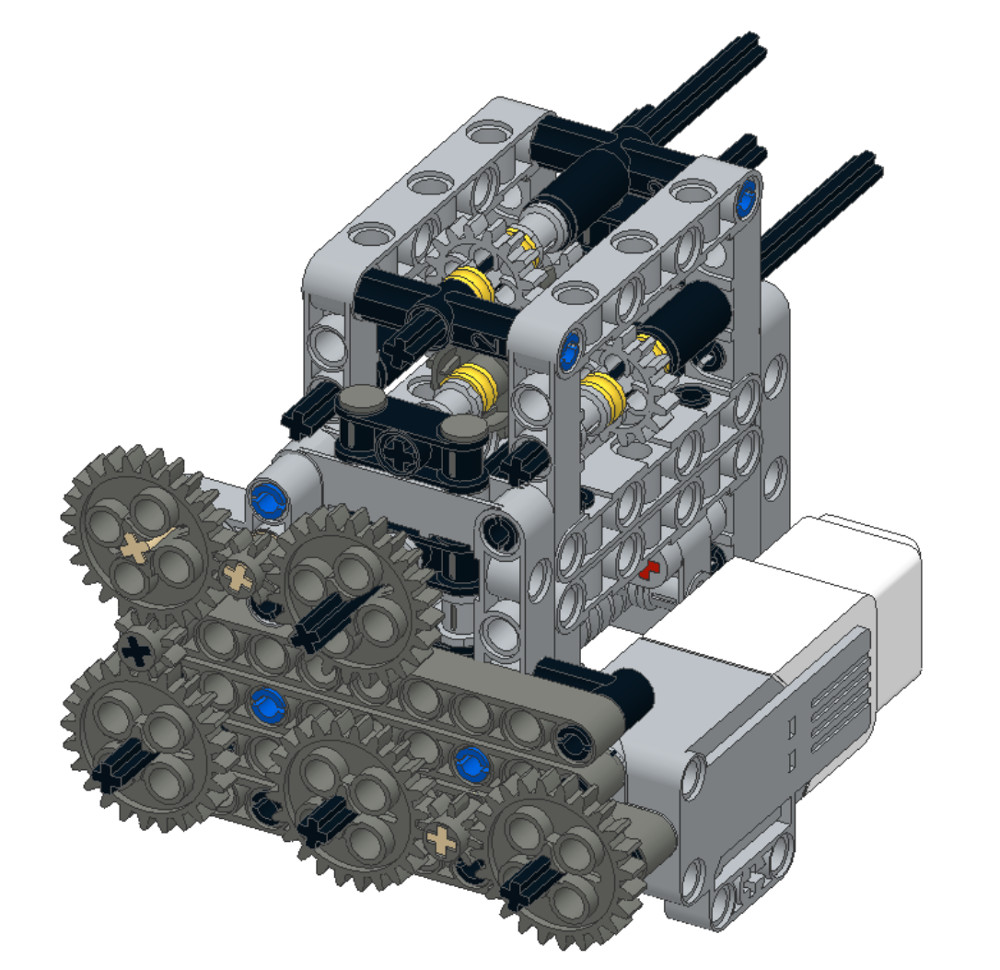Given the large number of gear wheels and axles in each EV3 and NXT sets there are many possibilities for building gear mechanisms. We are developing something like a gear box that has different axles that could all turn in different directions.
- #188
- 03 Jan 2016
- 5:32
With one of the motors we control the rotations of the driving axles. With the other we control which axles work with which.
This video is part of the course at:
Multi-axles, many-directional LEGO Mindstorms mechanism for transferring power (almost a gear box).
The mechanism at the end looks like:
Multi-axles mechanism instructions
Building instructions for a LEGO Mindstorms EV3 Multi-axles mechanism
Build the construction. Attach at least two wheels to some of the axles. Figure out how. Record a video or take a picture and share it with us in the comments section.
Tasks description, submission and evaluation are available to subscribed users.
Subscribe now to access the full capacity and get feedback.
English
In this video I would like to show you a very interesting mechanism for controlling 4 different axles with only 2 motors so we can do 4 different movements multiplied by 2 because they can be forward and reversed. We can do 8 movement with only 2 motors. This is how the whole mechanism works.
Now we have one of the axles rotating and I'm now changing for the other axle and if we continue the third axle will start rotating and if we continue we'll have the fourth axle right here rotating. Let's explore this mechanism.
You can actually call this mechanism a small gear box. At least it looks like a gear box. It has 2 motors. This is the first motor and the second motor and it has four axle.
With the 2 motors we can control whether want to rotate the 1st, 2nd, 3rd or 4th axle. Let's do a close view of how the whole mechanism works. I'll now start it.
You can see that we have this axle here rotating. Why? Because there is a gear wheel inside connected to the axle and somehow we are transfering power from the motors to this axle here and we can attach something to this axle, we can attach an attachment or another mechanism, we can transfer power. Now the main principle is the following. We have the motor it rotates the 1st gear wheel, the 2nd, the 3rd, the 4th, the 5th. This here connected to the gear wheel is the main axle and we are rotating this main axle. Inside the mechanism there is one more gear wheel, as you can see right here that's connected and this small gear wheel transfers the power to the axle that we choose, how do we choose and axle we use the second motor and with the second motor there is a machanism inside, I'll show it to you, that moves the small gear wheel inside, this one here, and it moves the whole gear wheel and in this way we select which axle to rotate. Now let's try to move it.
Now we start rotating. We can zoom it even further. Here it is. We have the gear wheel inside, that's currently working with this axle and now if we move the gear wheel in this direction it will connect with one of the gear wheels on the inside and we'll change the axle that's rotating.
Now we start rotating the other axle.
In this way by moving this gear wheel on the inside and moving it left to right and right to left, we can control which axle, currently, is rotating. Let's move the whole mechanism in the other direction.
That, I think, was a nice shot with the camera. Let's do this again, very briefly. I will start the program and I'll move the inside gear wheel in the other direction and I'll chage with which gear wheel it works and in this I'll change the axle. Now the question is how do we move this inside gear wheel right here? What's the mechanism that moves this gear wheel? If we stop the program and look at the bottom of the mechanism, you can see this interesting parts here. These are called worm gear, because they look like a worm and we actually move a small mechanism on the inside of this large mechanism using these worm gear wheels. I'll start the program again.
You can see that by rotating the worm gear there is something on the inside that we actually move.
Let's deconstruct and see how we move this.

